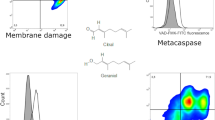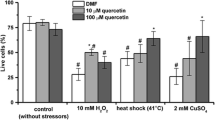Abstract
Captan is one of the most widely used broad-spectrum fungicide applied to control several early and late diseases of grapes, apples, and other fruits and vegetables, and as other phthalimide fungicides is defined as a multisite compound with thiol-reactivity. Captan can affect non-target organisms as yeasts, modifying microbial populations and fermentation processes. In this study, we asked whether Captan thiol-reactivity and other mechanisms are involved in acute Captan-induced cell death on aerobic growing Saccharomyces cerevisiae. Thus for, we analyze cellular protein and non-protein thiols, cell membrane integrity, reactive oxygen species accumulation, phosphatidylserine externalization, and apoptotic mutants behavior. The results showed that when submitted to acute Captan treatment most cells lost their membrane integrity and died by necrosis due to Captan reaction with thiols. However, part of the cells, even maintaining their membrane integrity, lost their culture ability. These cells showed an apoptotic behavior that may be the result of non-protein thiol depletion and consequent increase of reactive oxygen species (ROS). ROS accumulation triggers a metacaspase-dependent apoptotic cascade, as shown by the higher viability of the yca1-deleted mutant. Together, necrosis and apoptosis are responsible for the high mortality detected after acute Captan treatment of aerobically growing cells of S. cerevisiae.





Similar content being viewed by others
References
Angioni A, Garau VL, Del Real AA, Melis M, Minelli EV, Tuberoso C, Cabras P (2003) GC-ITMS determination and degradation of captan during winemaking. J Agric Food Chem 57:671–6766
Arce GT, Gordon EB, Cohen SM, Singh P (2010) Genetic toxicology of folpet and captan. Crit Rev Toxicol 40:546–574
Bertoldi M de, Griselli M, Giovannetti M, Barale R (1980) Mutegenicity of pesticides evaluated by means of gene-conversion in Saccharomyces cerevisiae and Aspergillus nidulans. Environ Mutagen 2:359–370
Bignami M, Aulicino F, Velcich A, Carere A, Morpurgo G (1977) Mutagenic and recombinogenic action of pesticides in Aspergillus nidulans. Mutat Res 46:395–402
Boyd D (2006) The food we eat: an international comparison of pesticide regulations. David Suzuki Fundation, Vancouver
Caboni P, Cabras P (2010) Pesticides influence on wine fermentation. Adv Food Nutr Res 59:43–62
Cabras P, Angioni A, Garau VL, Melis M, Pirisi FM, Farris GA, Sotgiu C, Minelli EV (1997) Persistence and metabolism of Folpet in grapes and must. J Agric Food Chem 45:476–479
Cadez N, Zupan J, Raspor P (2010) The effect of fungicides on yeast communities associated with grape berries. FEMS Yeast Res 10:619–630
Carmona-Gutierrez D, Eisenberg T, Büttner S, Meisinger C, Kroemer G, Madeo F (2010) Apoptosis in yeast: triggers, pathways, subroutines. Cell Death Differ 17:763–773
Chiba M, Brown AW, Danic D (1987) Inhibition of yeast respiration and fermentation by benomyl, carbendazin, isocyanates, and other fungicidal chemicals. Can J Microbiol 33:157–161
Conner AJ (1983) The comparative toxicity of vineyard pesticides to wine yeasts. Am J Enol Vitic 34:278–279
Demasi PD, Pereira GAG, Netto LES (2006) Influences of cytosolic thioredoxin peroxidase I and of the mitochondrial functional state. FEBS J 273:805–816
FAOReport (1997) http://www.fao.org/fileadmin/templates/agphome/documents/Pests_Pesticides/JMPR/Reports_1991-2006Report97.pdf. Accessed 29 July 2016
Gordon EB (2010) Captan and folpet. In: Krieger R (ed) Hayes handbook of pesticide toxicology. Elsevier, New York, pp 1915–1949
Lukens RJ (2013) The chemistry of fungicidal action. Springer, New York
Milenkovski S, Baath E, Lindgren PE, Berglund O (2010) Toxicity of fungicides to natural bacterial communities in wetland water and sediment measured using leucine incorporation and potential denitrification. Ecotoxicology 19:285–294
Penninckx MJ (2002) An overview on glutathione in Saccharomyces versus non-convencional yeasts. FEMS Yeast Res 2:295–305
Perrone GG, Grant CM, Dawes IW (2005) Genetic and environmental factors influencing glutathione homeostasis in Saccharomyces cerevisiae. Mol Biol Cell 16:218–230
Perrone GG, Tan SX, Dawes IW (2008) Reactive oxygen species and yeast apoptosis. Biochem Biophys Acta 1783:1354–1368
Scariot FJ, Jahn LM, Delamare APL, Echeverrigaray S (2016a) The effect of the fungicide captan on Saccharomyces cerevisiae and wine fermentation. Bio Web Conf 7:02027 https://www.bio-conferences.org/articles/bioconf/pdf/2016/02/bioconf-oiv2016_02027.pdf. Accessed 20 April 2017
Scariot FJ, Jahn LM, Maianti JP, Delamare APL, Echeverrigaray S (2016b) The fungicide Mancozeb induces metacaspase-dependent apoptotic cell death in Saccharomyces cerevisiae BY4741. Apoptosis 21:866–872
Sedlak J, Lindsay RH (1968) Estimation of total, protein-bound and nonprotein sulfhydryl groups in tissue with Ellman’s reagent. Anal Biochem 25:192–205
Sharma S (1986) The chemistry of thiophosgene. London series: Sulfur reports.In: Senning A, (ed). Harwood Academic Publishers, New York
Siegel MR, Sisler HD (1968) Fate of the phthalimide and trichloromethylthio (SCCl3) moieties of folpet in toxic action on cells of Saccharomyces pastorianus. Phytopathol 58:1123–1129
Simmon VF, Mitchell AD, Jorgenson TA (1977) Evaluation of selected pesticides as chemical mutagens: In vitro and in vivo studies. Research Triangle Park, NC: Health Effects Research Laboratory, US Environmental Protection Agency. Report n° EPA-600/1-77-028. MRID 132582
Vadkertiova R, Slavikova E (2011) Influence of pesticides on yeasts colonizing leaves. Z Naturforsch 66:588–594
Wloch-Salomon DM, Bem AE (2012) Types of cell death and methods of their detection in yeast Saccharomyces cerevisiae. J Appl Microbiol 114:287–298
Yang C, Hamel C, Vujanovic V, Gan Y (2011) Fungicide: mode of action and possible impact on nontarget microorganisms. ISRN Ecology 2011: Article ID 130289
Zeiger E (2004) History and rationale of genetic toxicity testing: An impersonal, and sometimes personal, view. Environ Mol Mutagen 44:363–371
Acknowledgements
The authors acknowledge Cytogene Diagnósticos Moleculares Ltda. for access to flow cytometry equipment. F. J. Scariot thanks Coordenação de Aperfeiçoamento de Pessoal de Nível Superior for fellowship support.
Author information
Authors and Affiliations
Corresponding author
Rights and permissions
About this article
Cite this article
Scariot, F.J., Jahn, L., Delamare, A.P.L. et al. Necrotic and apoptotic cell death induced by Captan on Saccharomyces cerevisiae . World J Microbiol Biotechnol 33, 159 (2017). https://doi.org/10.1007/s11274-017-2325-3
Received:
Accepted:
Published:
DOI: https://doi.org/10.1007/s11274-017-2325-3




